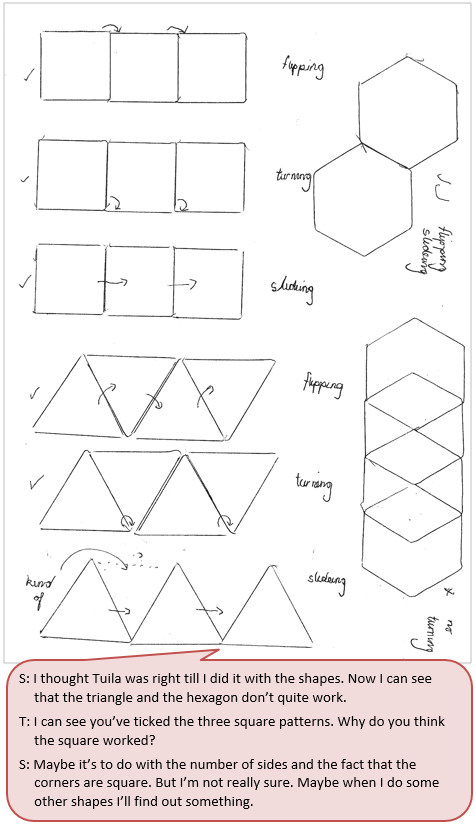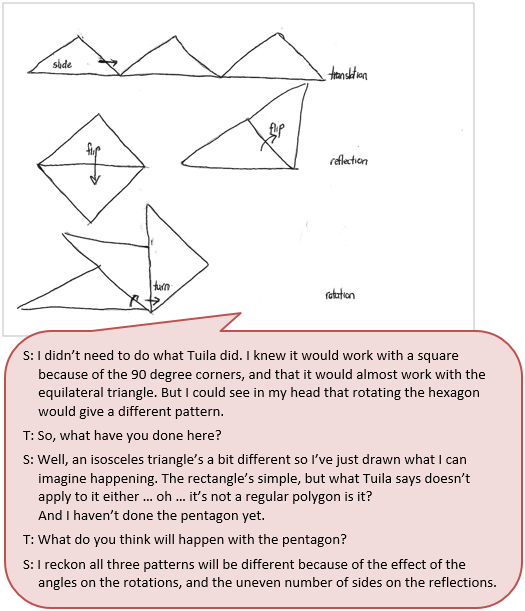The purpose of this activity is to engage students in an investigation into the results of transformations on given shapes.
This activity assumes the students have experience in the following areas:
- Translating, reflecting, and rotating shapes.
- Analysing patterns to see if a shape has been translated, reflected, or rotated.
- Creating patterns using translation, reflection, and rotation.
- Exploring how translation, reflection, and rotation affect the properties of shapes.
The problem is sufficiently open ended to allow the students freedom of choice in their approach. It may be scaffolded with guidance that leads to a solution, and/or the students might be given the opportunity to solve the problem independently.
The example responses at the end of the resource give an indication of the kind of response to expect from students who approach the problem in particular ways.
Tuila cuts these regular polygons out of cardboard.

She chooses one shape and draws around it. She then reflects (flips) it along one side, and draws around it again. She does this several times to make a pattern. Using the same shape, she makes a second pattern by rotating the shape (turning on a corner) and drawing around it. She then makes a third pattern with this shape by translating (sliding) the shape and drawing around it.
For the chosen shape, she finds that all of the patterns look the same, no matter whether she reflects, rotates or translates the shape to make the pattern.
Tuila says this happens with all three shapes.
- Do you think Tuila is right? Show how you know.
- Chose some other regular polygons and investigate to find if this is true for them.
The following prompts illustrate how this activity can be structured around the phases of the Mathematics Investigation Cycle.
Make sense
Introduce the problem. Allow students time to read it and discuss in pairs or small groups.
- Do I understand what is being asked? Could you act out what Tuila has to do?
- Do I know what the words mean? (Address the meaning of the transformations (reflection, rotation, and translation) by acting them out with different shapes.)
- What are different types of polygons I know? What Polygons would be good for pattern making?
- What will my answer look like? (The answer will be a collection of patterns created with different shapes and the three transformations.)
Plan approach
Discuss ideas about how to solve the problem. Emphasise that, in the planning phase, you want students to say how they would solve the problem, not to actually solve it.
- What maths ideas are involved in the problem? (Geometry, particularly creating frieze patterns with the transformations.)
- What do I already know about repeating patterns of shapes? What types of patterns do I know about? Where do I find patterns like that?
- What tools might be useful? (Physical shape cutouts and digital drawing tools are useful.)
- Which shape and which transformation will I begin with?
- What different shapes would I like to try?
Take action
Allow students time to work through their strategy and find a solution to the problem.
- Have I followed the transformations correctly? How can I tell?
- Are my drawings easy for someone else to follow?
- Do my patterns have things in common? Do my patterns differ? How?
- Can I predict the pattern before I make it? How?
- What language can I use to describe my patterns?
Convince yourself and others
Allow students time to check their answers and then either have them pair share with other groups or ask for volunteers to share their solution with the class.
- What is my answer? Are the patterns all correct? Have I checked?
- How might I convince someone else that my patterns are correct?
- Did I create enough patterns to generalise what happens to a shape as it is reflected, rotated, or translated?
- Can I now predict the pattern that a transformation on a shape will create? How can I predict the pattern?
- What properties of shapes change and stay constant when they are reflected and rotated?
- What could I find out next? What happens when I combine transformations?
Examples of work
Work sample 1
The student follows the instructions to Tuila with different shapes to form patterns. They conclude that the patterns for a square are the same but the patterns vary for other shapes.
Click on the image to enlarge it. Click again to close.
Work sample 2
The student imagines the effects of rotations on different shapes.

